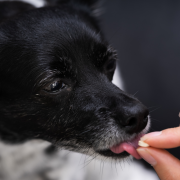Date:
By Alan Green and Lisa Olsen
It is interesting that different species metabolize substances in various ways. Sometimes, what is a treat in one species can be lethal in another. This is certainly the case for the artificial sweetener Xylitol. This month’s guest contributor is Dr. Lisa Olsen. Dr. Olsen, one of CVRC’s critical care specialists, writes about a very important topic in pets — xylitol poisoning.
As pet owners, we are all too familiar with the dangers of the most common toxic human foods — chocolate, raisins, grapes, onions and garlic. However, one that often goes overlooked is the newer artificial sweetener, xylitol. A naturally occurring plant sugar alcohol, the commercial product is synthesized from birch trees. Found in sugarless gum, sugarless candies, some baked goods and more recently in low-calorie peanut butters and some compounded human medications, this product is harmless to humans and can be beneficial for those trying to manage diabetes or encourage weight loss.
However, the sweetener is highly toxic, even deadly, to dogs. Undesirable symptoms range from mild hypoglycemia (low blood sugar) to liver failure, or even death. The number of cases has more than doubled since 2007 when toxicity began to be recorded and in 2015 more than 3,700 calls to the ASPCA Pet Poison Hotline involved suspicion or confirmed ingestion of this toxin. As some ingestions are likely not reported, this is thought to be an underestimate of the actual number of annual cases.
Even a few sticks of gum or similarly small amount of other xylitol containing products can stimulates a dog’s pancreas to release the hormone insulin. This surge of insulin results in a rapid drop in the body’s blood sugar to dangerously low levels, in as little as 30 minutes, though these effects can be delayed up to several hours. Signs of low blood sugar can range from drowsiness, weakness and disorientation in mild cases, to seizures, coma or even death in more severe cases. If this should develop, treatment involves intravenous fluids containing a sugar replacement (dextrose), or other medications to help maintain normal blood sugar while the toxin is eliminated from the body, which can take up to 24 to 48 hours.
Even dogs that do not develop signs of hypoglycemia are at serious risk of toxic effects. In the days to weeks following ingestion, as the toxin is metabolized and eliminated by the liver, serious organ injury can occur. Though not immediately evident, delayed liver damage or even failure can develop. Signs of liver failure include yellowing of the skin and eyes (jaundice), vomiting, decreased appetite and other “flu-like symptoms.” Unfortunately, although potentially preventable, once liver failure develops limited treatment options are available.
The ASPCA poison control center advises looking for any of the following inactive ingredients, all synonyms for xylitol: 1,4-anhydro-d-xylitol, anhydroxylitol, birch bark extract, birch sugar, d-xylitol, xylite, xylitylglucoside, zylatol. The Preventative Vet website contains a more complete list of products containing various levels of xylitol.
Because of the potential seriousness this toxin can pose, rapid and diligent medical attention is imperative. To be sure this early adverse effect is managed, vets may advise testing the pet’s blood sugar and monitoring the pet in the hospital for up to 12 hours. In addition, early initiation of prescription liver protective medications may slow, reduce or — in some cases —prevent the development of liver injury. If you suspect that your pet has ingested a product containing xylitol, contact your veterinarian immediately. If your primary veterinarian is not available, Charleston Veterinary Referral Center is available 24 hours a day, seven days a week and will work with your vet to be sure your pet is well cared for.


















